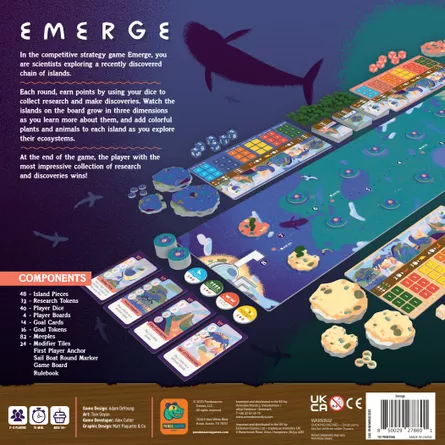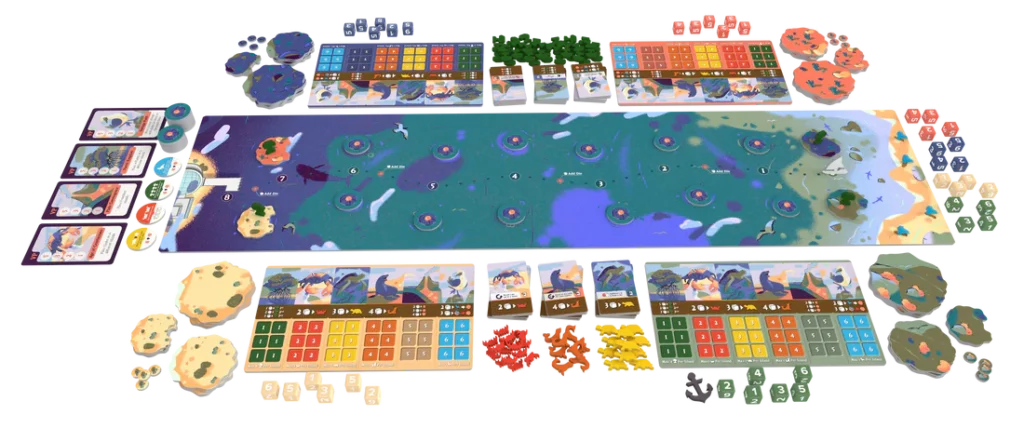Emerge Board Game Review
If a game has cute wooden pieces included in the box, there is a solid chance it’s something I’m going to enjoy. I’m only half kidding, of course – I’m not going to play a really bad game just because it has animeeples, am I? Am I? Thankfully, Emerge from Pandasaurus Games is bringing a familiar concept to the table but in a whole new way, and after playing half a dozen games over the past week or so, I’m ready to share how much I’ve enjoyed this experience!
Overview – What is Emerge?
In Emerge, players are researchers finding new discoveries on islands formed by the emergence of land masses below the ocean as a result of volcanos. As these new islands form and grow taller, players will research plants, animals and more, to create diversified ecosystems to ultimately score points.
Played over 8 rounds, Emerge brings deep, strategic gameplay to the table, with simple and easy to understand rules and turn orders. After moving the ship and flipping up research tiles, players manipulate their player boards to give themselves the best odds for getting the specific items they are looking for. Then, throw those dice and begin placing your beautiful foliage, animals, and island tiles on the board.
After 8 rounds, players tally up their scores from their islands, unused research tokens, and the shared victory point cards, and the highest score wins!
An Easy Game to Table
While there might be a ton of pieces and tiles associated with Emerge, the core concept of the game is really simple. When teaching this to my wife for the first time, I had the game setup and we were actively playing within 15 minutes. While it took her a few turns to understand how all the systems worked, she was flying by round 3 and ultimately took the game by over 10 points.
The main way you will score points in Emerge is diversifying your islands. At the start of the game, each players board will have 6 different actions they can take, corresponding to the six sides of a die. A plant always needs to be placed on and island before animals, and animals must be placed in a specific order (crab, turtle, seal). Using dice, players can perform these actions. Here is a list of the basic actions printed on player boards (by die face):
- Place a tree for one “1” die, a second tree on an island for two “1” dice, and a third tree on an island for three “1” dice
- Place a crab for two “2” dice
- Place a turtle for three “3” dice
- Place a seal for four “4” dice
- Grow a small island into a medium island for three “5” dice; grow a medium island into a large island for four “5” dice
- Fly a bird from the mainland to your island for two “6” dice; steal a bird from another island for three “6” dice
At the beginning of each round, players can manipulate their player board by taking a tile from the board and placing it over any spot on their player board. For example, the game recommends you take the “Plant” tile and place it overtop the “Seal” location on your board. For that round at least, you can now grow trees when rolling both “1” and “4,” increasing your odds of placing trees.
These modifier tokens are not limited, but only one can be added each round; instead of adding a tile, players can instead rearrange the tiles on their player board into a new configuration. There is always the option to remove one tile per round.
Simple Ruleset, Deep Strategy
There is a lot of strategy in how you manage your player board throughout the game. While there is that chance of a bit of the luck of the roll, all the modifier tokens you can place do give you a dice modification bonus, like adding 1 or 2 to a die, removing 1 or 2 from a die, re-rolling all of the same number, etc. It’s not always going to work out, but the game does let you use unwanted dice for purchasing research tokens (which further diversify your strategy by giving you items for a cheaper price).
Ultimately, though, I just love the simplicity and flow of the game. It’s so smooth throughout, and a simple rule set means very little referencing of the rulebook or discussions or disagreements between players. With so little to remember, you can spend your time focusing on the best strategy, or altering your strategy based on the dice rolled.
While I do think Emerge is a bit heavier than a gateway game, it does almost meet that requirement. Players relatively new to more complex board games might enjoy this option, as will veteran players. It’s fun to play, and charming as well!


